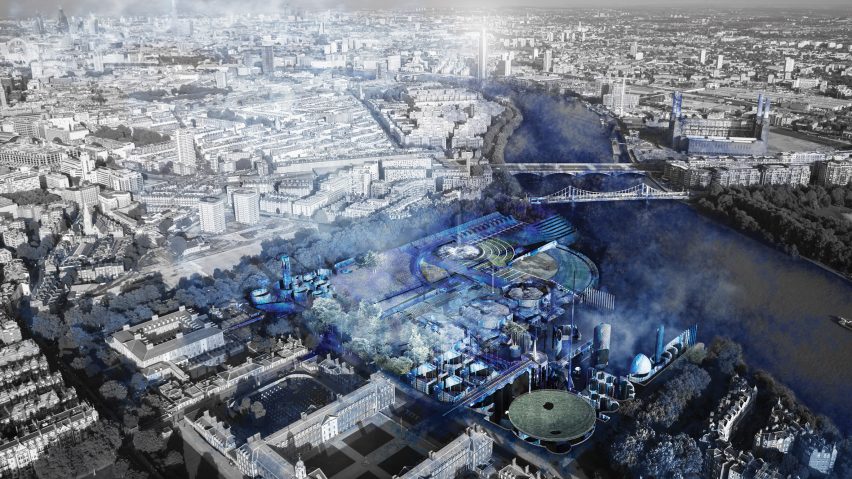Bartlett School of Architecture student Sam Coulton has designed a concept for a sustainable alternative to cremation to help Londoners confront death.
Called London Physic Gardens: A New London Necropolis, Coulton's proposal, which he created on his MAarch course at the Bartlett, involves building a new city of the dead where Chelsea's pleasure gardens once stood.
Here, the city's corpses wrapped in blue-printed shrouds would be used to grow plants for the RHS Chelsea Flower Show, with the dye leaching into the water cycle to slowly stain the city a cerulean colour.
The project is a response to Unit 12 at the Bartlett's theme of A City in a Building in a City, where students were invited to devise "intimate megastructures".
In responding to the prompt, the architecture masters student was compelled to address the relationship between London's living and it's dead.
His project focuses on the issues of "extreme climate uncertainty, population growth and political instability due to impulsive decision making with little regard for the past or future Londoner" the city currently faces.
"Britain as a whole is particularly Victorian in its attitude to death and to public space," Coulton told Dezeen.
"[I hope] that the introduction of this new kind of abstract necropolis would shock the living Londoner into engaging environmentally and socially."
Burial space in London is incredibly limited and with 200 Londoners a day opting to be cremated atmospheric pollution is a growing concern.
Coulton believes death is still taboo in many cultures including the UK and that London will have to become less death-averse in order to dispose of its dead without polluting its air.
Resomation is an environmentally friendly alternative where the process of alkaline hydrolysis is harnessed to break a body down into its chemical components using water, lye, pressure and heat. The resulting liquid contains amino acids, sugars and salts and can be used to nurture plants.
"Cremation uses enormous amounts of energy in comparison to resomation," Coulton explained.
"In 1960 about 30 per cent of deceased Britons were cremated, now it is over 70 per cent. Attitudes continue to change and if flames are better than worms, why is water not preferable to either?"
Bodies arriving at the London Physic Gardens would be wrapped in a blue shroud printed using the cyanotype process with patterns of the necropolis structures, rendered obliquely.
Inside the resomation chamber, the Prussian blue pigment would leach into the water, which is then used to water the gardens.
This blue water would also leach from the soil into the Thames, dying the river blue. It would also enter the water cycle, raining down on the city and eventually staining its buildings blue, too.
The gradual colouring would serve as a constant reminder of death and the impact of climate on the city.
Prussian blue is an environmentally neutral dye, and can even be prescribed as a treatment to the exposure of radiation. It's used to treat thallium poisoning or radioactive cesium poisoning, although side effects include turning your poo blue.
The gardens would be filled with exotic species that would multiply along with the number of bio-creations, providing specimens for the horticultural festival and a place for mourners to visit.
"It acts as a celebration of life, rather than purely a place for mourning," said Coulton.
"The introduction of a physic garden requires the visitor, viewer or reader to engage differently with the space, in an attempt to make it more accessible and alter our perceptions of death, climate and time."
Part philosophy, part architectural protest, Coulton came up with the idea for a blue musing on death after exploring the works of punk filmmaker, gardener and gay rights activist Derek Jarman, and the artist Yves Klein.
"I became fascinated by the relationship all of Jarman's work has to time and colour; specifically his cottage in Dungeness," said Coulton.
Jarman designed the shingle garden around his Kentish home, where scrubby plants grow amongst sculptures made from rubbish and driftwood against a seaside-blue sky.
"He also directed the film 'Blue' as he was losing his sight to AIDS in 1993, which for me, highlighted this relationship between the colour blue and attempting to somehow solidify or memorialise the immaterial," he added.
"He was inspired himself by Yves Klein's extreme blue renderings of the sky as a means to depict 'the void', and in the way Klein described this as something eternal, transcending human life and time itself."
Death and funerary rites provide architects and designers with fertile ground if they are prepared to engage with the macabre.
At MIT Neri Oxman devised a collection of 3D-printed death masks filled with pigment-producing microorganisms that function as biological urns. In the Netherlands Studio Nienke Hoogvliet have created a biodegradable urn for cremains made from wastewater bioplastics.

